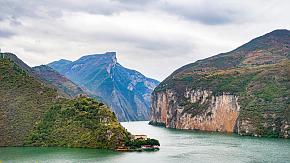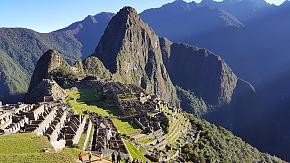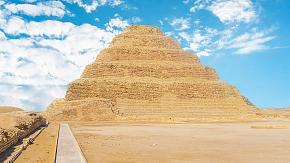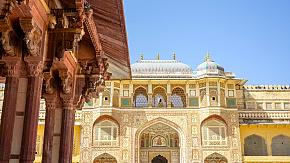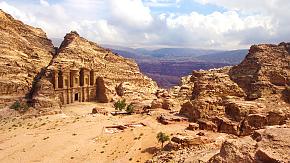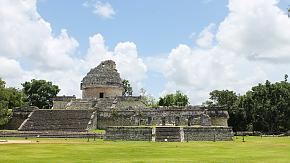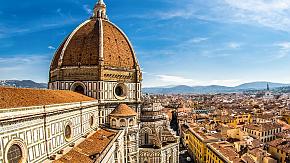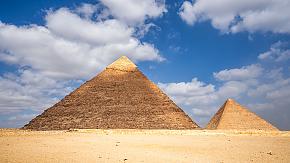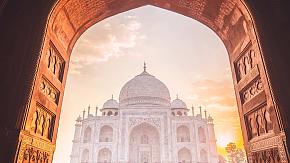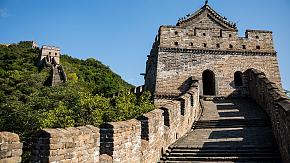New 7 Wonders of the World: Great Wall, Machu Picchu, Taj Mahal & More
In 2007, a non-profit organization called the New 7 Wonders named 7 new wonders of the world without ranking: The Great Wall (China), Machu Picchu (Peru), Taj Mahal (India), Petra (Jordan), Christ the Redeemer Statue (Brazil), Chichen Itza (Mexico), and the Roman Colosseum (Rome). The declaration was a result of more than 100 million votes on the Internet.
According to New 7 Wonders, the factors taken into consideration include the time span that covers human history, structure that must have been built by human, full-scale geographic dimension, having artistic and cultural values, presenting diversity, must be universally recognizable and so on. Check the details below to see why they are on the list.
Great Wall
Location: From the east coast to the west desert, China.
Found: 7th BC
Stretching 5,500 miles (8,850 kilometres) across the northern borders of China, the Great Wall is acknowledged as the longest man-made structure ever built by UNESCO. These fortifications made of stone, wood, fach brick, compacted earth along with other materials without the use of modern machines. It is believed that some part of the wall dates back to as early as the 7th BC (more than 2,000 years ago), while the bigger sections were joint later, especially the one built between 220-206 BC by the first emperor of China, Emperor Qin. However, very little of that section remains. The purpose of building the wall was to protect the people from invaders, and new sections were added in different eras with the majority of the existing wall was built since the Ming Dynasty.
The Chinese authorities released a survey concluding that the Great Wall starts from the eastern coast and winds into the far western deserts, stretching through various landscapes, 15 provincial regions and over 400 towns. It is not surprising that in Chinese the wall is commonly called "the ten-thousand li (a half-kilometer) Great Wall", and there is a famous Chinese saying goes like "He who does not reach the Great Wall is not a true man".
For first-time visitors, it is suggested visit the Mutianyu Section in Beijing, which is well-preserved and accessible to all types of tourists. More adventurous travelers can check out less-preserved sections such as Jiankou, Jinshanling, Simatai, or Gubeikou.
Machu Picchu
Location: Cusco Region, Peru
Found: 1450 CE
Crowned as the top destination to visit, Machu Picchu well deserves the reputation. Back in the 15th century, the Incas built the citadel on an impressive mountain ridge rising more than 2,000 meters above sea level in Cuzco. Machu Picchu was the summer resort of the Inca emperor Pachacutec (1438 - 1472), who directed the massive stone masons that provide not only residency for many people, but also served as religious areas, if not purely an epitome of fine artworks.
Despite the fact that local people are well aware of the existence of this city, it is until 1911 that American archeologist Hiram Bingham gets his first look at Machu Picchu, 500 years being forgotten. And since then it has been brought to global attention.
The settlement is constructed with polished dry-stone walls, which is not hard to find around the area. However, it requires unimaginable efforts to build 140 buildings that perch on top of a mountain. Construction materials are a must, let alone food supplies and water. It is believed that more than 5,000 people participated in the construction work. The sheer size, grandeur, legendary location and the irrigation system are part of the reasons why Machu Picchu keeps wowing world visitors year round.
The Great Pyramid of Giza
Location: Cairo, Egypt
Found: 2580-2560 BC
The reason that I put the Great Pyramid of Giza here is obvious, even though the New7Wonders doesn't include it on their website. The sole remaining one from the ancient world, the Great Pyramid of Giza represents a marvel of human engineering and construction. The structure possesses an incredible symmetry and near perfect proportions, which make it a truly specular appearance in the massive desert.
The size and scale of the pyramid is a miracle, and how it was built remains a mystery even in today. It took the Egyptians 20 years to build the pyramid during the reign of the king Khufu of the 4th Dynasty. Constructed out of 2.3 million stone blocks with each weighing between 2¬-15 tons, the weight of the whole settlement is estimated nearly 6,000,000 tons. The length of each side at the base is an average of 755 feet and it covers an area of 5.3 hectares. Evidence shows that it was originally 481 feet tall, but has shrunk to 25 feet due to the lost of its top.
As for how the pyramid was built, some believe that the Egyptians wet the sand in front of an equipment made to create heavy items, while some studies suggest that kites were used to lift the ultra-heavy stones. Moreover, many speculate that slave labor was used to build the pyramid, others are more convinced by the employment of civil service. No matter what could have been the truth, it is amazing to look at given the fact that it was built more than 3,000 years ago.
To better help you plan a trip to the pyramids, we have summed up Q&As to Demystify the Incredible Pyramids in Egypt.
Taj Mahal
Location: Arga, India
Found: 1632-1653 AD
The final resting place of Arjuman Banu and his wife Mumtaz Mahal, Taj Mahal is a showpiece of the Mughal architecture. The construction of the cenotaph took more than 20 years to finish, with thousands of elephants, artisans and craftsmen were hired to complete the work. The delicate exterior and interior motifs and carvings were all done by hand. To understand what all the fuss is about, think about the fact the monument was built in an age that there were no computers, standardized construction techniques and machines.
Taj Mahal is a fusion of elements of Islamic, India, Persian and Turkish styles of art. Materials used were imported from over India and Asia, specially the white marble from Rajasthan, sapphire from Sri Lanka, jade and crystal from China, lapis lazuli from Afghanistan. Built to reflect the sky, the grand mausoleum changes its colors during the day: it appears pinkish in the early morning, milky white at noon, golden at sunset, silver or grey-blue at night.
More than just looking magnificent, Taj Mahal is well known by the love story behind it. Shah Jahan spent six months alone to decide the site on which Taj Mahal would stand, which demonstrates his ambitious dedication for the project. Many admire the affection Shah Jahan had for his wife, and the soul given to the monument makes it vividly appealing. Muhammad Amin Qazwini, the court historian of Shah Jahan, described Taj Mahal as "a masterpiece for ages to come, increasing the amazement of all humanity".
Petra
Location: Ma'an Governorate, Jordan
Found: As early as the 5th century BC
Between the 14th century and the 19th century Petra remained a "lost city" to the western world. No data suggested exactly when it was built, probably dating back to the first century AD as the style of the majestic construction reflects the civilization of the Nabataeans, a nomadic tribe inhabited northern Arabia and the Southern Levant.
A few famous movies, such as Indiana Jones and the Lost Crusade, feature the rose-red city, which now is one of the most prominent archaeological sites in the world. Home to more than 800 carved monuments, Petra encompasses burial sites, baths, temples, facades and streets, all carved out of sandstone. When you are there, it is hard not to imagine how it was built with simply cutting tools, yet every piece of the site was made to meet the finest standard of art. The Nabataeans didn't seem to be bothered with the location which is set in in a remote desert. A spring channel was built to let water flow into the city, cisterns were created to store rainwater, and a bath pool surrounded by beautiful gardens. Sounds like an unachievable dream? But the Nabataeans apparently knew their onions.
Although Petra has been in the center for decades, archaeologists claim that 85% of Petra is still underground, undiscovered and untouched, which brings more excitement for future explorers.
Christ the Redeemer
Location: Rio, Brazil
Found: 1931 CE
Measuring over 200 feet tall on Mount Corcovado rising 2,300 foot, Christ the Redeemer is a gigantic Jesus statue overlooking the city of Rio de Janeiro in Brazil.
The idea of building a colossal depiction of Jesus came after World War I, when followers thought they need a symbol to retrieve the godness which seemed to vanish quickly since the Brazilian republic was established in 1889. Local engineer, Heitor da Silva Costa, designed the statue in 1920 and it was then sculpted by French sculptor Paul Landowski. It took nine years to complete the cross-shaped statue that is made of reinforced concrete and soapstone, which are believed to last longer.
Although not even being a very old statue, Christ the Redeemer has become a famous landmark of Rio and a symbolic protector of people and the soul. It now attracts over 600,000 visitors a year, remaining of the most important tourist destinations in the world.
Chichen Itza
Location: Yucatán, Mexico
Found: 9th century
Built by the pre-Columbian Mayan civilization, Chichén Itzá is believed by archeologists to have been a powerful economic city in 600 AD. If you are not familiar with the Mayan, they were the people who created their own writing forms, a calendar, and developed star charts. The site was dedicated to a plumed serpent deity called Kukulkan with an incredibly well-planned layout designed as a calendar.
The name of Chichén Itzá translates as "the Mayan city of Stone" for the pyramid-shaped settlement is made out of pure stones. The structure measures 24 meters high with an extra height of 6 meters for the temple, covering an area of 55.3 meters across. There are 18 square terraces connected with stairways, each has 91 steps, up each of the four sides to the temple on top, so it is 365 steps (days) in total to make a solar year. The most iconic part of the structure is the serpent shadow which can be seen during the spring and autumn equinoxes. One of these days, when sun rays fall on the architecture at a particular angle, the shadow on the staircases creates an illusion of a serpent running down the pyramid.
Chichén Itzá is also known for the unusual sounds if you do a clap, it produces a different frequency of echoes in different sites of the architecture, which is quite captivating to try in person.
Roman Colosseum
Location: Rome, Italy
Found: 70 AD
In Rome's ancient days, amphitheaters were built in the heart of the city. The Roman Colosseum is the largest among all in the world built during Roman Empire between 72 A.D and 80 A.D. Commissioned by the Roman Emperor Vespasian who founded the Flavian dynasty, it is originally known as the Flavian Amphitheatre.
The Colosseum has an oval shape, measuring 189 meters long, 156 meters wide and 50 meters high. Built from travertine stone and concrete collected from local sources, the Roman Colosseum is a brilliant masterpiece of architecture that had 80 entrances and a capacity of 50,000 spectators for public entertainment. It took nine years to complete the structure, with almost 60,000 slaves used. Sporting events and games were held here, mostly animal hunts and gladiatorial combats. These were brutal games that we wouldn't feel comfortable watching but they were some of the best national pastimes back at that time. Numerous rooms and underground passages were built below the Colosseum to hold animals and gladiators before the game started.
It is a shame that two-thirds of the structure has been damaged over time due to natural disasters and human activities, nonetheless, it remains one of the most visited tourist sites on the planet with around 4 million tourists every year.
The announcement of the new seven wonders of the world is inspiring and making people more aware of the cultural legacy left to us and our next generation. Odynovo takes private tours to most of these amazing sites (while Brazil, Mexico and Italy are not available at the moment), so feel free to contact us for a personalized itinerary or find inspiration with our sample tours to worldwide destinations.
Related Posts You May Like
What Our Clients Say
Explore the latest verified reviews of Odynovo's travel services on Tripadvisor, Google, Trustpilot, Product Review and more trusted platforms.

